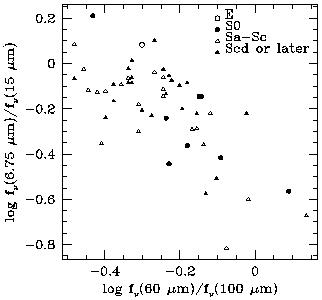


3.2 Mid-Infrared Photometry
ISO-CAM (Césarsky et al. 1996)
has obtained striking images of galaxies
between 4 and 18µm, showing dust emission in nuclear
regions, outlining
the spiral arms, and tracing the disk out to the Holmberg radius and beyond
(Malhotra et al. 1996,
Sauvage et al. 1996,
Vigroux 1997,
Boselli & Lequeux 1997,
Smith 1998).
There are clear color variations within spiral
galaxies, some of which have not yet found satisfactory explanations
(Helou et al. 1996;
Tran 1998).
Mid-infrared colors derived from ISO-CAM are
effective discriminants between stellar photospheres and dust as sources of
emission. Lenticular galaxies often have contributions from both of those
sources
(Madden et al. 1997;
Boselli et al. 1998).
Rouan et al. (1996),
Block et al. (1997)
and Smith (1998)
have combined mid-infrared and Br images with other broad-band and line images to estimate star formation
rates, ISM parameters, obscuration and dust properties. These studies
again point to Aromatic Feature carriers as a ubiquitous component of
interstellar dust, to the likely destruction of these carriers by ionizing
UV, and to dust heating being derived from both old stars and OB stars in
non-starburst disk galaxies.
images with other broad-band and line images to estimate star formation
rates, ISM parameters, obscuration and dust properties. These studies
again point to Aromatic Feature carriers as a ubiquitous component of
interstellar dust, to the likely destruction of these carriers by ionizing
UV, and to dust heating being derived from both old stars and OB stars in
non-starburst disk galaxies.

|
Figure 2. The ISO-IRAS color-color diagram for galaxies in the ISO Key Project on normal galaxies (Helou et al. 1996). The progression of colors can be readily explained by a simple two-component model similar to that of Helou (1986). |
The 6.75-to-15µm color ratio formed from ISO-CAM bands
remain relatively
constant and near unity as the ISM of galaxies proceeds from quiescent to
mildly active (Figure 2). As dust heating
increases further, the
15µm flux increases steeply compared to 6.75µm,
pointing to a
significant contribution by dust at color temperature
100 K < TMIR < 200 K, typical of a heating intensity up to
104 times
that of the diffuse interstellar radiation field in the local Milky Way
(Helou et al. 1997).
While such a temperature could result from classical
dust heated within or just outside HII regions, it is probably more
accurate to associate this component empirically with the observed emission
spectrum of HII regions and their immediate surroundings
(Tran 1998;
Contursi 1998).
This emission has severely depressed AFE, and is dominated
by a steeply rising though not quite a blackbody continuum, consistent with
mild fluctuations in grain temperatures,
 T/T ~ 0.5.
This HII region hot dust component becomes detectable when the color
temperature from the 60-to-100µm ratio is half TMIR,
demonstrating the broad distribution of dust temperatures within any galaxy
(Helou 1986).
T/T ~ 0.5.
This HII region hot dust component becomes detectable when the color
temperature from the 60-to-100µm ratio is half TMIR,
demonstrating the broad distribution of dust temperatures within any galaxy
(Helou 1986).
At the other end of the spectrum, photometry at 120-200µm using ISO-PHOT is starting to constrain the distribution of dust temperatures at low heating levels, especially in nearby well resolved galaxies such as M31 (Haas et al. 1998), M51 or M101 (Hippelein et al. 1996), where cold dust dominates the luminosity. Similar analysis on more active galaxies is also under way (e.g. Klaas et al. 1997).